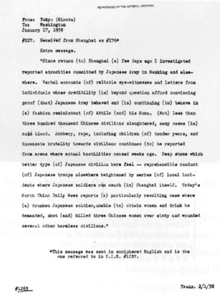- Nanjing War Crimes Tribunal
-
Battle of Nanking (1937) Nanking Safety Zone
Japanese war crimes Contest to kill 100 people using a sword
International Military Tribunal for the Far East Nanjing War Crimes Tribunal
Historiography of the Nanking Massacre Nanking Massacre denial
Nanjing Massacre Memorial Hall
Japanese history textbook controversiesFilms The Battle of China
Black Sun: The Nanking Massacre
City of Life and Death
Don't Cry, Nanking
The Flowers of War
John Rabe
Nanking
Tokyo Trial
The Truth about NanjingBooks American Goddess at the Rape of Nanking
The Good Man of Nanking
The Rape of Nanking
Tokyo Harold John Timperley's telegram of 17 January 1938 describing some atrocities and used as proof against Hisao Tani
Harold John Timperley's telegram of 17 January 1938 describing some atrocities and used as proof against Hisao Tani
The Nanjing War Crimes Tribunal was established in 1946 by the government of Chiang Kai-Shek to judge four Japanese Imperial Army officers accused of crimes committed during the Second Sino-Japanese War. It was one of thirteen tribunals established by the Nationalist government.
The accused were Lieutenant General Hisao Tani, company commander Captain Gunkichi Tanaka and Second Lieutenants Toshiaki Mukai and Tsuyoshi Noda, made famous by the contest to kill 100 people using a sword.
General Yasuji Okamura was convicted of war crimes in July 1948 by the Tribunal, but was immediately protected by the personal order of Nationalist leader Chiang Kai-shek[1], who retained him as a military adviser for the Kuomintang (KMT).[2]
While he was questioned by the investigators, he however testified about the Nanking massacre :
"I surmised the following based on what I heard from Staff Officer Miyazaki, CCAA Special Service Department Chief Harada and Hangzhou Special Service Department Chief Hagiwara a day or two after I arrived in Shanghai. First, it is true that tens of thousands of acts of violence, such as looting and rape, took place against civilians during the assault on Nanking. Second, front-line troops indulged in the evil practice of executing POWs on the pretext of (lacking) rations."
As Iwane Matsui had been judged by the Tokyo tribunal; Prince Kotohito Kan'in, Kesago Nakajima and Heisuke Yanagawa had been dead since 1945; Isamu Cho had committed suicide and Prince Asaka had been granted immunity by General Douglas MacArthur as member of the imperial family, Hisao Tani was the only officer prosecuted for the Nanking massacre. He was found guilty on 6 February 1947 and executed on 10 March by a firing squad. All the accused were sentenced to death in 1947.
According to the verdict of the Tribunal for Tani, on 10 March 1947, there were more than 190,000 civilians and Chinese soldiers killed by machine gun whose corpses were burned to destroy proof. Besides, we count more than 150,000 victims of barbarous acts buried by the charity organisms. We thus have a total of more than 300,000 victims.» [4] This estimate was made from burial records and eyewitness accounts.
The death toll of 300,000 is the official estimate engraved on the stone wall at the entrance of the Memorial Hall for Compatriot Victims of the Japanese Military's Nanjing Massacre in Nanjing.
See also
Notes
- ^ Herbert Bix, Hirohito and the Making of Modern Japan, 2000, p.594
- ^ Budge, [1] Pacific War Online Encyclopedia
- ^ Akira Fujiwara, Bob Wakabayashi (2007). The Nanking Atrocity 1937-1938 : Complicating the Picture. Berghan Books.
- ^ Tokushi Kasahara, Le massacre de Nankin et les mécanismes de sa négation par la classe politique dirigeante, http://www.ihtp.cnrs.fr/IMG/pdf_interventionsnankin-francais.pdf
References
Philip R. Piccigallo, The Japanese on Trial : Allied War Crimes Operations in the East, 1945–1951, University of Texas press, 33, 73
Categories:- World War II war crimes trials
- Japanese war crimes
- Crimes against humanity
- Crime of aggression
Wikimedia Foundation. 2010.
